Ever since I first laid eyes on a Betta fish, I’ve been fascinated by their dazzling display of colors and intricate fin designs. Known scientifically as Betta splendens, these creatures, often referred to as Siamese fighting fish, are a favorite among aquarium enthusiasts and pet owners alike. Their unique aesthetic is not the only aspect that sets them apart – their behavioral traits and survival adaptations are equally captivating.
You might wonder why Betta fish are so popular. Well, their charm is quite hard to resist. The spectrum of colors they come in, from brilliant blues to radiant reds, thanks to selective breeding, is an instant draw. Furthermore, their relative ease of care makes them an excellent choice for both novice and experienced fish keepers. They are indeed a spectacle to behold, whether they’re gliding gracefully in a tank at home or displayed in an ornate aquarium at a pet store.
In their natural habitat, Betta fish call the Mekong basin of Laos, Cambodia, Vietnam, and Thailand their home. These resilient creatures are found thriving in a variety of water bodies, including rice paddies, floodplains, canals, and slow-moving streams. One of their remarkable survival strategies is their ability to breathe atmospheric air. This extraordinary adaptation, thanks to a special organ called the labyrinth organ, allows them to survive even in low-oxygen water conditions.
As I delve deeper into the world of Betta fish, I continue to be amazed by their unique traits and behaviors. Male Bettas, in particular, are known for their aggressive nature, a trait that earned them the nickname “Siamese fighting fish.” But don’t let that intimidate you. With proper care and understanding of their needs, these fish can make an exciting addition to your home aquarium. Despite their aggressive reputation, they can live up to 3-5 years in captivity.
Just when you think you’ve heard it all, Betta fish continue to surprise. Did you know they are bubble nest builders? The male betta meticulously creates a nest of bubbles at the water’s surface, where the eggs will be placed after spawning. And here’s another fun fact: Betta fish are named after an ancient clan of warriors, “Bettah,” symbolizing their fighting spirit.
The history of Betta fish intertwines with human culture, tracing back to the mid-1800s in Siam (now Thailand). They were not always the vibrant, colorful fish we see today. Wild bettas were of dull green and brown hues, far from the rainbow-colored varieties that we are familiar with. Their transformation into the radiant creatures we know and love can be credited to selective breeding. From their humble beginnings in the rice paddies of Southeast Asia, Betta fish have indeed come a long way. They have not only adapted and survived but thrived and charmed their way into homes and hearts worldwide.
If you ask me, Betta fish are more than just pets. They are a testament to nature’s incredible diversity and adaptability, encapsulating an extraordinary blend of beauty, resilience, and complexity.
Table of Contents
Understanding Betta Fish: Price and Alternative Names
The price of a Betta fish can vary significantly depending on a variety of factors including the specific breed, coloration, fin type, age, and the location and reputation of the seller. A common Betta fish may cost around $5 to $10 in the United States at pet stores. However, rarer types, such as the Halfmoon, Rosetail, and Plakat bettas, or ones with unique colors or patterns can be priced anywhere from $20 to several hundred dollars.
Bettas purchased from reputable breeders or through international sellers may also come with a higher price tag due to the quality and health of the fish. It’s always important to research and buy from responsible sources to ensure the well-being of the fish.
In terms of alternative names, the Betta fish is known around the world by several names. The most common alternative name is the “Siamese fighting fish,” which originates from the fish’s history in Siam (now Thailand) and its aggressive nature.
They are also sometimes referred to as “Japanese fighting fish,” a misnomer likely due to confusion or association with Siamese fighting fish. Another name you might encounter is “Chinese fighting fish,” although their origin is not in China.
In their native region, Betta fish are often referred to as “Plakat,” which means “tearing” or “ripped paper” in Thai, likely referring to their long, flowing fins.
Different types of Betta fish breeds are also known by specific names such as Veiltail, Crowntail, Halfmoon, Delta, and more, which are primarily descriptive of their tail and fin shapes.
Creating the Ideal Home: Tank Size and Water Parameters for Betta Fish
When it comes to creating a comfortable living environment for your Betta fish, tank size and water parameters are of paramount importance.
Starting with tank size, a common misconception is that Betta fish can thrive in small bowls or vases. This belief likely stems from their ability to survive in low-oxygen environments thanks to their labyrinth organ. However, “surviving” and “thriving” are two very different things. A minimum tank size of 5 gallons is recommended for a single Betta fish. This provides them with enough room to swim and explore, promoting a healthier and more active lifestyle. If you plan on keeping more fish or adding tank mates, a larger tank will be necessary.
The water parameters are another crucial aspect of Betta fish care. Betta fish are tropical freshwater fish, so they prefer warm water. The water temperature should ideally be kept between 76-82 degrees Fahrenheit (24-28 degrees Celsius). Consistency in temperature is vital, so a heater and a thermometer are essential aquarium equipment.
Bettas prefer slightly acidic to neutral water, so aim for a pH between 6.5 and 7.5. The water hardness should be between 2-5 dKH (soft water) but they can adapt to harder water if necessary. It’s also crucial to maintain low levels of ammonia, nitrite, and nitrate, which are harmful to fish. Regular water changes, typically 25% per week, can help maintain water quality.
In terms of filtration, a low-flow filter is recommended. Bettas aren’t strong swimmers and prefer calm water, so a filter that doesn’t create a strong current is ideal.
Lastly, the aquarium should have a lid or cover. Bettas are jumpers and could leap out of the tank if given the chance. The cover should have some holes or gaps, however, to allow the Betta to breathe atmospheric air.
Betta Fish: Lifespan and Full Size Details
One of the things that make Betta fish popular pets is their relatively long lifespan for a fish. If properly taken care of, a Betta fish can live for anywhere between 3 to 5 years on average, with some even reaching up to 7 years in rare instances. This lifespan allows pet owners to form a connection with their Betta fish and observe their behaviors and personalities over time.
The lifespan of a Betta fish can be significantly influenced by the conditions in which it lives. Factors such as diet, tank size, water quality, temperature, stress, and genetics all play a role in determining how long a Betta fish will live. Regular care, including feeding a balanced diet and maintaining clean and stable water conditions, can help ensure that a Betta fish lives a long and healthy life.
A fully grown Betta fish typically measures between 2 to 2.5 inches (5 to 6.35 cm) in body length, excluding the tail. However, this can vary slightly depending on the specific breed and genetic factors. Males generally have longer fins, which can add to their overall length. This size makes them suitable for a variety of tank sizes, although a larger tank allows for more swimming and exploration space, which can contribute to the fish’s overall well-being.
Female Betta Fish
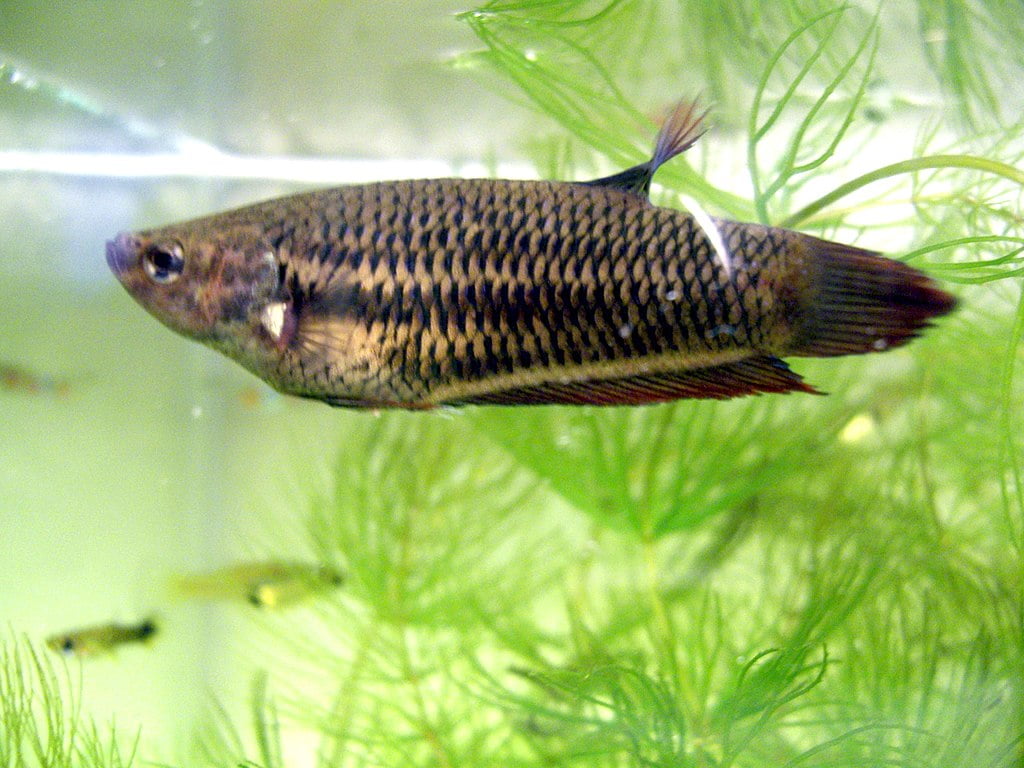
Female Betta fish, though not as commonly sought after as their male counterparts, are equally fascinating and display their unique charm and characteristics. Unlike males, female Bettas have shorter fins and bodies. Their colors, while still vibrant, are generally less intense compared to the often flamboyant display of male Bettas. Nonetheless, they still come in a wide array of beautiful colors and patterns, making them a delightful addition to any aquarium.
Behaviorally, female Bettas tend to be less aggressive than males, but they can still exhibit territorial behaviors. Female Betta fish can live together in what’s known as a “Betta sorority” – a group of female Bettas living in the same tank. However, it’s crucial to monitor them closely for signs of aggression and ensure the tank is large enough with plenty of hiding spots. It’s also worth noting that while female Bettas don’t typically display the same level of fin flare as males when threatened, they do share the characteristic ‘beard’ – a membrane under their gill covers that extend outward when they feel threatened.
Blue Betta Fish
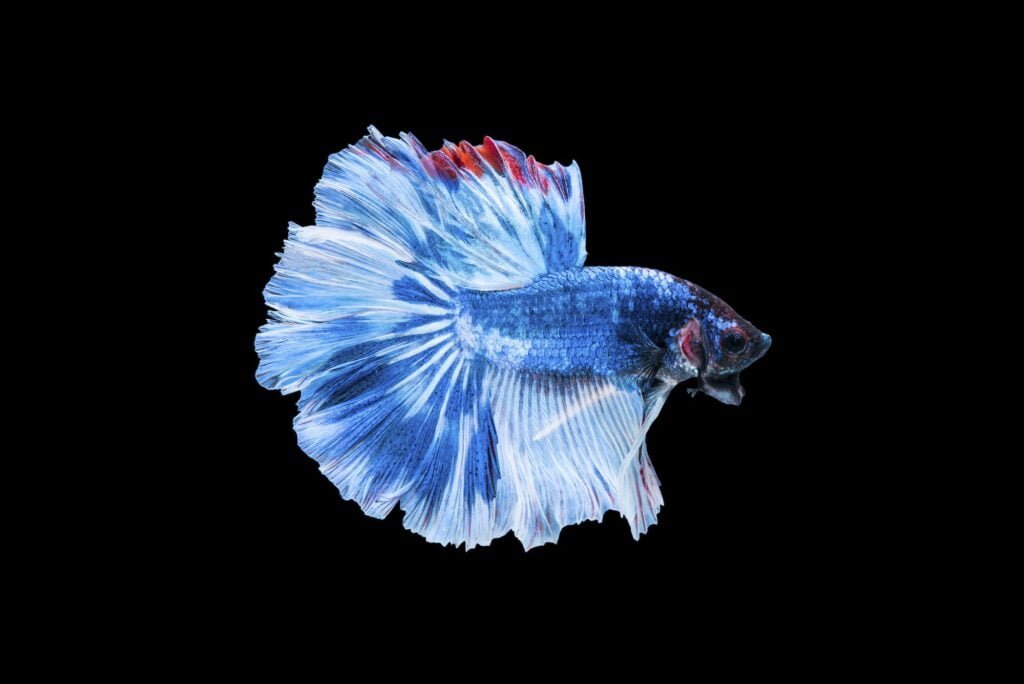
Blue Betta fish are among the most popular color variants in the hobby due to their vibrant and eye-catching hues. Their shades can range from light, sky-blue to deep, royal blue, often with a beautiful iridescent sheen that sparkles under the right light. These colors are the result of a combination of pigments and the structure of their scales, which can reflect light in a way that intensifies their blue coloration.
The color of a Betta fish, including the blue Betta, can be influenced by a variety of factors including genetics, diet, water conditions, and overall health. The genetics of color in Betta fish is quite complex. Crossing two blue Betta fish doesn’t always result in blue offspring due to the intricacies of Betta fish color genetics. Some genes are dominant, meaning they will be expressed over other colors, while others are recessive and will only show if both parents carry the gene. Moreover, there are variations of blue, such as steel blue and royal blue, which are controlled by different sets of genes, adding another layer of complexity to the color-crossing process. It’s this fascinating blend of science and chance that makes breeding Betta fish for color an interesting challenge for many Betta enthusiasts.
Purple Betta Fish
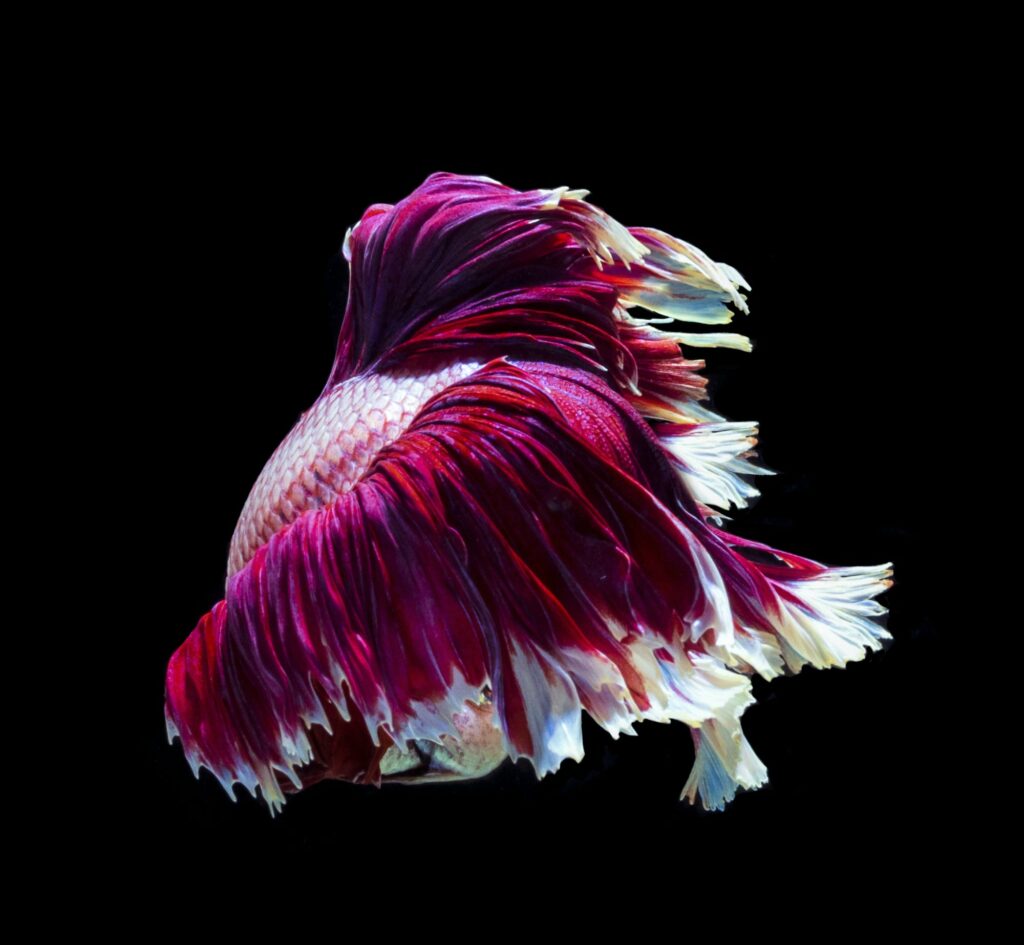
Purple Betta fish are among the rarest and most sought-after colors in the Betta world. They are highly prized for their unique and vibrant color, which can range from pale lavender to a deep, royal purple. The purple color is often more noticeable under certain lighting conditions or when the fish is excited or stressed. A fully purple Betta fish is a rare sight, as many purple Bettas have a mix of blue, red, or even black coloration in their fins or body. The iridescent scales of Betta fish can also reflect light in a way that can give the appearance of a purple hue.
The coloration of Betta fish, including purple, is determined by various types of pigment cells called chromatophores. The crossing of colors to create a purple Betta fish is a complex process and involves careful selective breeding. Breeders often cross Bettas with strong red and blue colors in the hope of producing purple offspring. However, due to the complex genetics of Betta fish coloration, breeding for a specific color like purple can be a challenging and lengthy process, and there’s no guarantee of producing a fully purple Betta. Even if a purple Betta is produced, the color may change over time due to factors like age, diet, and stress.
White Betta Fish
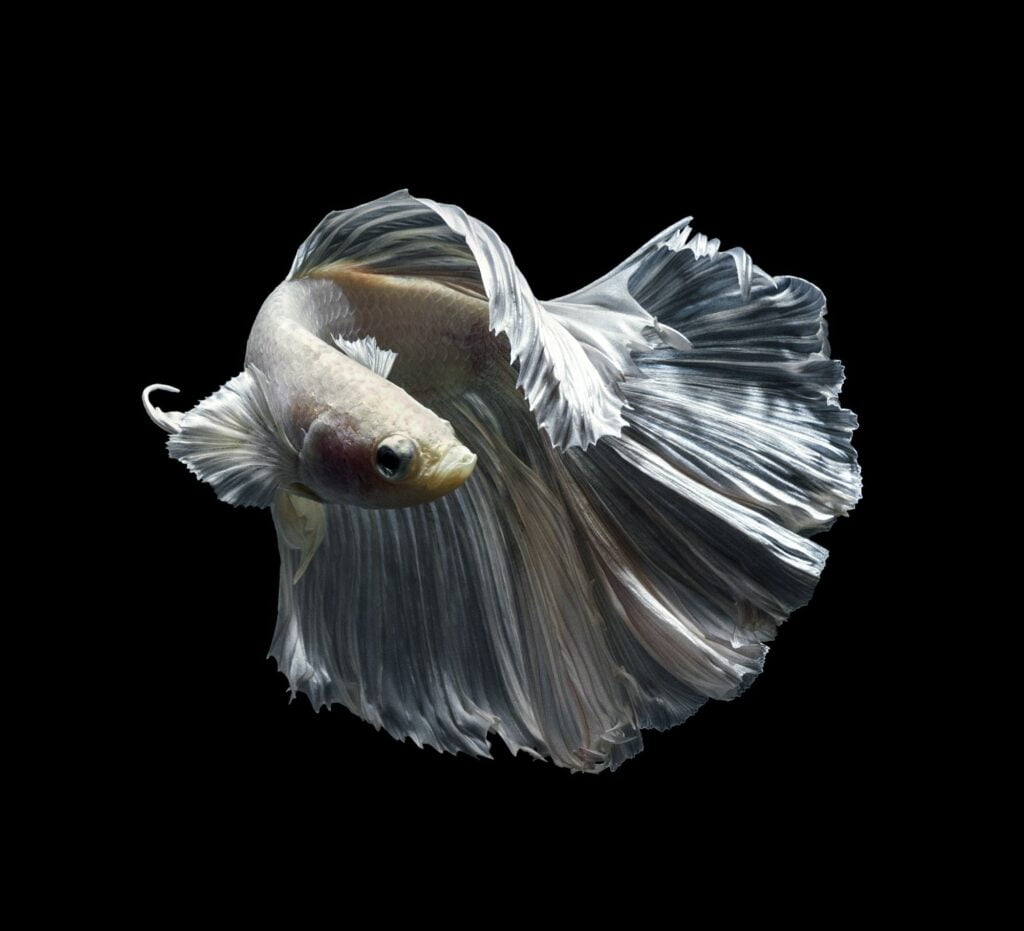
White Betta fish, known for their pristine and striking appearance, are a unique and captivating variant of the Betta splendens species. With their scales and fins ranging from pure white to a soft iridescent hue, they’re often described as elegant and ethereal, easily standing out in any aquarium setup. White Betta fish can come in various fin types and can be either completely solid white or display a slight iridescence under certain light conditions, adding to their appeal and allure.
Despite their undeniable beauty, white Betta fish are relatively rare. The genetics behind producing a completely white Betta fish are complex, making them less common than their vibrantly colored counterparts. Additionally, maintaining the pure white coloration can be challenging, as they can sometimes change color with age or under stress, often developing patches of blue or red. These factors contribute to the rarity and fascination surrounding white Betta fish, making them a sought-after choice for many Betta enthusiasts.
Black Betta Fish
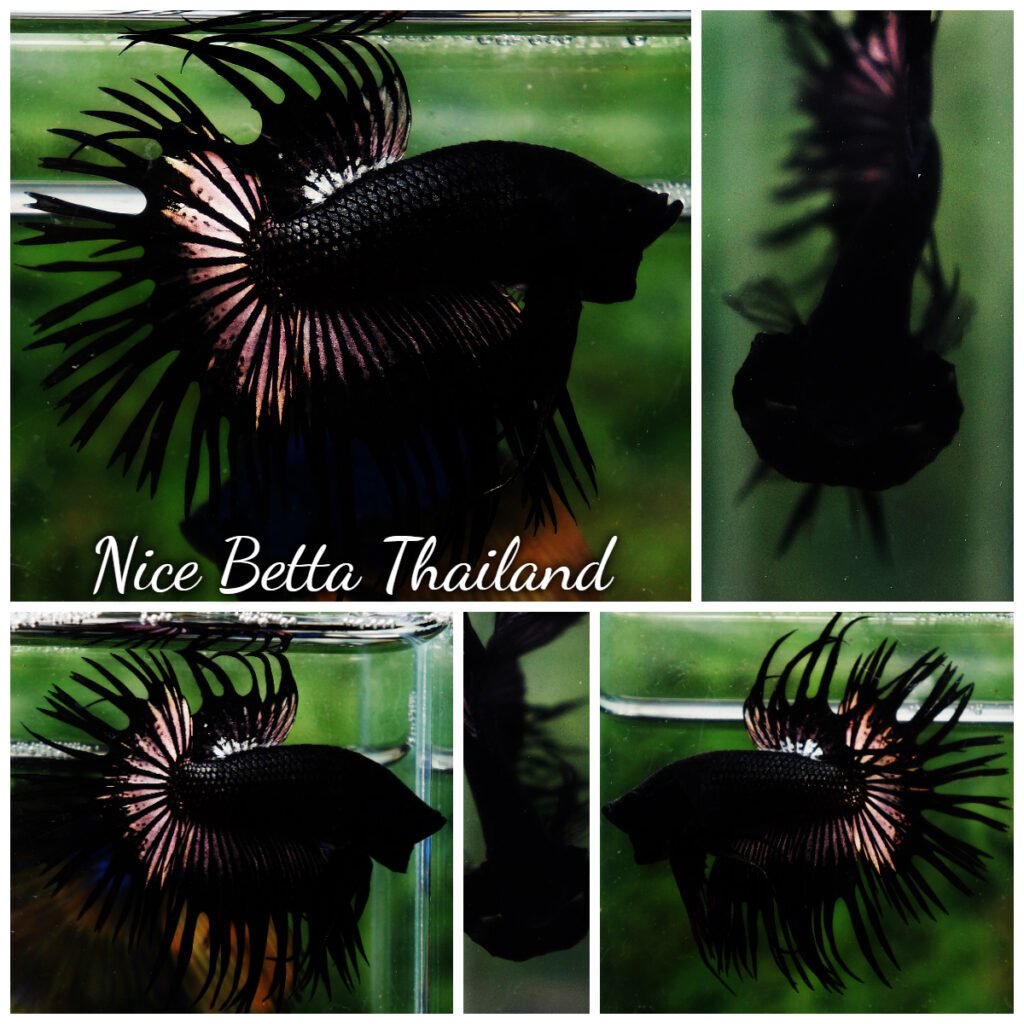
Black Betta fish, often referred to as “Black Orchid,” “Black Devil,” or “Black Melano,” stand out with their captivating, deep-black coloration. Their rarity and striking appearance make them highly sought after among Betta enthusiasts. Black Betta fish are not often found in nature and their scarcity is largely due to genetic factors. Melano Bettas, the true black Bettas, carry a gene that makes breeding challenging, as females are often sterile.
Their stunning dark hues provide a stark contrast against the colorful backdrop of an aquarium, making them a captivating centerpiece. The beauty and rarity of these dark gems undeniably add an exotic touch to any aquatic collection.
Exploring the Natural Environment: Behavior, Habitat Preference, and Aquarium Decoration for Betta Fish
Understanding the natural environment and behavior of Betta fish is crucial in providing them with a comfortable and stimulating home.
Betta fish, native to the Mekong basin in Southeast Asia, are adapted to live in varied environments including rice paddies, floodplains, and slow-moving streams. They prefer warm, slightly acidic to neutral water, and their ability to breathe atmospheric air allows them to survive in water with low oxygen levels.
Behaviorally, Bettas are solitary and territorial, particularly the males. They are known to be aggressive towards other males and to a lesser extent towards females and other species, especially those with similar bright colors or long fins. It’s essential to keep this in mind when considering tank mates.
When it comes to aquarium decoration, creating an environment that mimics their natural habitat can make Betta fish more comfortable and less stressed. This includes a combination of open swimming areas and places where they can hide or rest.
A few broad-leafed live plants, like Java Fern or Anubias, are excellent as they provide cover and resting spots. Betta fish are known to rest on these leaves near the surface of the water. Silk plants can also be used, but plastic ones should be avoided as they can tear the Betta’s delicate fins.
Adding some hiding spots, such as caves or hollow logs, can also be beneficial. These can provide your Betta with a sense of security and a place to retreat.
The substrate can also be added. A darker-colored substrate often helps the colors of the Betta fish stand out more. Just be sure to choose a substrate that doesn’t have sharp edges that could harm your Betta.
Remember that while Bettas aren’t strong swimmers, they do enjoy having some space to explore, so try to balance open areas with the decorated sections in your tank.
Fostering Harmony: A List of Suitable Tank Mates for Betta Fish
While Betta fish are known for their aggressive behavior, especially males, they can cohabit with other fish species given the right conditions. When choosing tank mates for your Betta, consider peaceful, fast-moving fish that are not fin-nippers and do not resemble Betta fish in terms of bright colors or long, flowing fins. It’s also vital to ensure that any tank mates thrive in similar water conditions as Betta fish. Here’s a list of fish that could potentially live peacefully with a Betta:
- Neon Tetras: Neon Tetras are small, peaceful fish that can coexist with Bettas due to their quick swimming and preference for the middle and lower levels of the tank.
- Ghost Shrimp: Ghost Shrimp are small, peaceful invertebrates that contribute to tank cleanliness. Their small size and quick movements allow them to coexist with Bettas.
- Corydoras Catfish: Corydoras Catfish are bottom dwellers that won’t compete with Bettas for space. Their peaceful nature and contribution to tank cleanliness make them a good match.
- Harlequin Rasboras: Harlequin Rasboras are peaceful fish that prefer the middle and upper levels of the tank, complementing the Betta’s swimming habits.
- Mystery Snails: Mystery Snails are peaceful invertebrates that contribute to tank cleanliness. Their hard shell provides protection from curious Bettas.
- African Dwarf Frogs: These frogs are peaceful creatures that won’t disturb the Betta. Their unique behavior adds an interesting dynamic to the tank.
- Zebra Snails: Zebra Snails are peaceful invertebrates that contribute to tank cleanliness. Their hard shell provides protection from curious Bettas.
- Kuhli Loaches: Kuhli Loaches are peaceful bottom dwellers. Their nocturnal habits and quick movements allow them to coexist with Bettas.
- White Cloud Mountain Minnows: These minnows are peaceful fish that prefer cooler water, but can adapt to the Betta’s preferred temperature. Their quick swimming allows them to coexist with Bettas.
- Guppies: Guppies are small, peaceful fish that can coexist with Bettas. However, it’s best to choose guppies with short fins and less flashy patterns to avoid provoking the Betta.
- Otocinclus Catfish: Otocinclus are small, peaceful catfish that contribute to tank cleanliness. Their preference for the bottom and sides of the tank allows them to coexist with Bettas.
- Cherry Shrimp: Cherry Shrimp are small, peaceful invertebrates that contribute to tank cleanliness. Their quick movements and small size allow them to coexist with Bettas.
- Platies: Platies are peaceful fish that prefer the middle and upper levels of the tank, complementing the Betta’s swimming habits.
- Featherfin Rainbowfish: These fish are peaceful and prefer the upper levels of the tank, allowing them to coexist with Bettas.
- Endler’s Livebearers: Endler’s are small, peaceful fish that can coexist with Bettas due to their quick swimming and preference for the middle and upper levels of the tank.
- Dwarf Crayfish: Dwarf Crayfish are small, peaceful invertebrates that contribute to tank cleanliness. Their hard shell provides protection from curious Bettas.
- Bristlenose Plecos: Bristlenose Plecos are peaceful bottom dwellers. Their hard, armored bodies and preference for the sides and bottom of the tank allow them to coexist with Bettas.
- Pygmy Corydoras: Pygmy Corydoras are smaller than regular Corydoras but are still peaceful and contribute to tank cleanliness. Their preference for the bottom of the tank allows them to coexist with Bettas.
- Ember Tetras: Ember Tetras are small, peaceful fish that prefer the middle and lower levels of the tank, complementing the Betta’s swimming habits.
- Nerite Snails: Nerite Snails are peaceful invertebrates that contribute to tank cleanliness. Their hard shell provides protection from curious Bettas.
These are potential tank mates and the success of keeping them with a Betta fish can depend on individual fish personalities. Always monitor new additions closely for any signs of aggression or stress. If the tank mates show signs of stress or the Betta becomes aggressive, it may be necessary to separate them.
Optimal Nutrition: The Best Foods for Your Betta Fish
Feeding your Betta fish a balanced diet is key to ensuring their health and longevity. Betta fish are carnivores by nature, requiring a protein-rich diet to thrive.
Quality Betta fish pellets are often the go-to choice for many Betta owners. They are nutritionally balanced and specifically formulated for Betta fish. Pellets should be high in protein (look for whole fish or fish meal as the first ingredient) and low in fillers like wheat or soy.
Flakes can also be used, but they often lead to overfeeding and are not as nutritionally dense as pellets. If you choose flakes, ensure they are specially formulated for Bettas.
In addition to pellets or flakes, it’s beneficial to occasionally supplement your Betta’s diet with live or frozen foods. These can include brine shrimp, daphnia, bloodworms, and mosquito larvae. Such foods mimic their natural diet and can help keep your Betta healthy and vibrant.
Feeding your Betta a variety of foods can help ensure they get a wide range of nutrients. However, avoid overfeeding as it can lead to obesity and water quality issues. A general rule of thumb is to feed an amount that your Betta can consume within two minutes, once or twice a day.
Every Betta fish is unique and their dietary needs can vary. Adjust the type and amount of food based on your Betta’s age, size, health, and activity level. Always monitor your Betta’s behavior and appearance to ensure they are getting the nutrition they need.
Propagating the Species: Breeding Tips for Betta Fish
Breeding Betta fish can be a rewarding experience for aquarists but it’s important to note that it requires significant time, patience, and care.
Ideal Conditions for Betta Fish Breeding
To start, ensure that both male and female Betta fish are healthy and mature enough to breed, usually around 6-12 months old. They should be fed a high-protein diet to prepare them for the breeding process.
The breeding tank should be a minimum of 10 gallons and have a heater and a thermometer. The water temperature should be slightly warmer than usual, around 80-82 degrees Fahrenheit (26.7-27.8 degrees Celsius), to encourage breeding behaviors.
The tank should have a cover as the male Betta will build a bubble nest at the water surface, which is a part of the breeding process. Also, consider using a sponge filter to keep the water clean without creating strong currents that can disrupt the bubble nest.
Adding live plants or a breeding mop can provide the female with hiding spots if the male becomes too aggressive.
Steps to Successful Betta Fish Breeding
- Condition the Bettas: Feed the male and female a diet high in protein for about two weeks before introducing them. This helps them gain the energy needed for breeding and increases the chances of successful spawning.
- Introduce the Bettas: Place the female in the breeding tank but separate her from the male using a transparent divider or place her in a clear container. This allows the fish to see each other without the risk of aggression.
- Bubble Nest Building: If the male is ready to breed, he will start building a bubble nest on the surface of the water.
- Release the Female: Once the nest is built and the female shows vertical stripes (breeding bars), indicating she’s ready to spawn, they can be allowed to interact. Monitor them closely, as the male may become aggressive. If the female hides and does not come out, or if the male harm her, they should be separated again.
- Spawning: The male will wrap himself around the female in a spawning embrace. The female will release her eggs, which the male will fertilize. After each embrace, the female will float in a trance-like state while the male picks up the eggs and places them into the bubble nest.
- Post-Spawning: Once spawning is finished, remove the female from the tank. The male will look after the eggs and fry. After the fry starts swimming freely, usually after 2-3 days, remove the male as well.
- Rearing the Fry: Feed the fry with infusoria or commercially available fry food until they are big enough to eat larger foods. Keep the water clean and maintain a stable temperature.
Keeping a Betta fish can be a rewarding experience, filled with vibrant colors and charming personality right in your living room. These feisty little creatures have more to them than what meets the eye. Ensuring they have the right environment, proper nutrition, and suitable companions, if any, will allow them to thrive and showcase their full potential. If you’re up for an aquatic adventure, Betta fish could be your perfect finned friend. So, dive in, and embark on the fascinating journey of being a Betta parent. And remember, every moment spent understanding and caring for your Betta contributes to a healthier, happier, and more colorful life for them – and for you.
FAQs
How many fish can I put in my tank?
For Betta fish, it’s generally recommended to keep one Betta per tank due to their territorial nature, especially if they are males. However, if you have a larger tank with enough hiding spots and you want to introduce other non-aggressive species, always research compatibility and monitor behavior closely.
How often should I feed my fish?
Betta fish should be fed once or twice a day, with only as much food as they can eat within two minutes. Overfeeding can lead to obesity and water quality issues.
How do I maintain the water quality in my tank?
Maintain water quality by regularly testing the water parameters (pH, ammonia, nitrite, and nitrate levels) and performing partial water changes weekly. Remove uneaten food and waste promptly.
How often should I clean my aquarium?
You should do partial water changes (about 25-50%) once a week for a Betta fish tank. The tank itself should be deep-cleaned as needed, usually every few months, but always make sure not to remove all beneficial bacteria.
How to identify if my fish is sick?
Signs of a sick Betta may include clamped fins, loss of appetite, lethargy, faded color, spots or patches on the body, or abnormal swimming. Always seek veterinary advice if you suspect your Betta is ill.
What are the common diseases in freshwater fish and how can I treat them?
Common diseases in Betta fish include fin rot, ich, velvet, and dropsy. Each disease has specific treatments, often involving water changes, medication, and sometimes changes in diet or temperature. Always seek advice from a vet or aquatic specialist if you suspect a disease.
Can I add live plants to my aquarium? What are the benefits?
Yes, you can add live plants to your Betta fish tank. They provide hiding spots, help improve water quality by absorbing nitrates, and can make your fish feel more at home. Good choices for Bettas include java fern, anubias, and amazon sword.
Does Betta fish sleep?
Yes, Betta fish do sleep, typically at night. They often rest on the bottom of the tank, on leaves, or in Betta hammocks. It’s normal to see them lying on their side while sleeping.
What is the Betta fish behavior before death?
Betta fish may show signs of illness before death, such as loss of appetite, lethargy, faded color, or abnormal behavior. However, a sudden death could occur without noticeable signs, especially if due to old age.
How long can Betta fish go without food?
While Betta fish can survive up to two weeks without food, it’s not recommended to leave them without food for more than a few days. Long periods without food can cause stress and health issues.
Do Betta fish need a heater?
Yes, Betta fish are tropical fish and thrive in water temperatures between 76-82°F (24-28°C). A stable, warm temperature can be maintained with a heater, especially in cooler climates.
Why is my Betta fish not eating?
Bettas might not eat due to various reasons, including illness, stress, poor water conditions, or unfamiliarity with a new type of food. If your Betta refuses to eat for more than a couple of days, it’s crucial to identify and address the underlying issue.
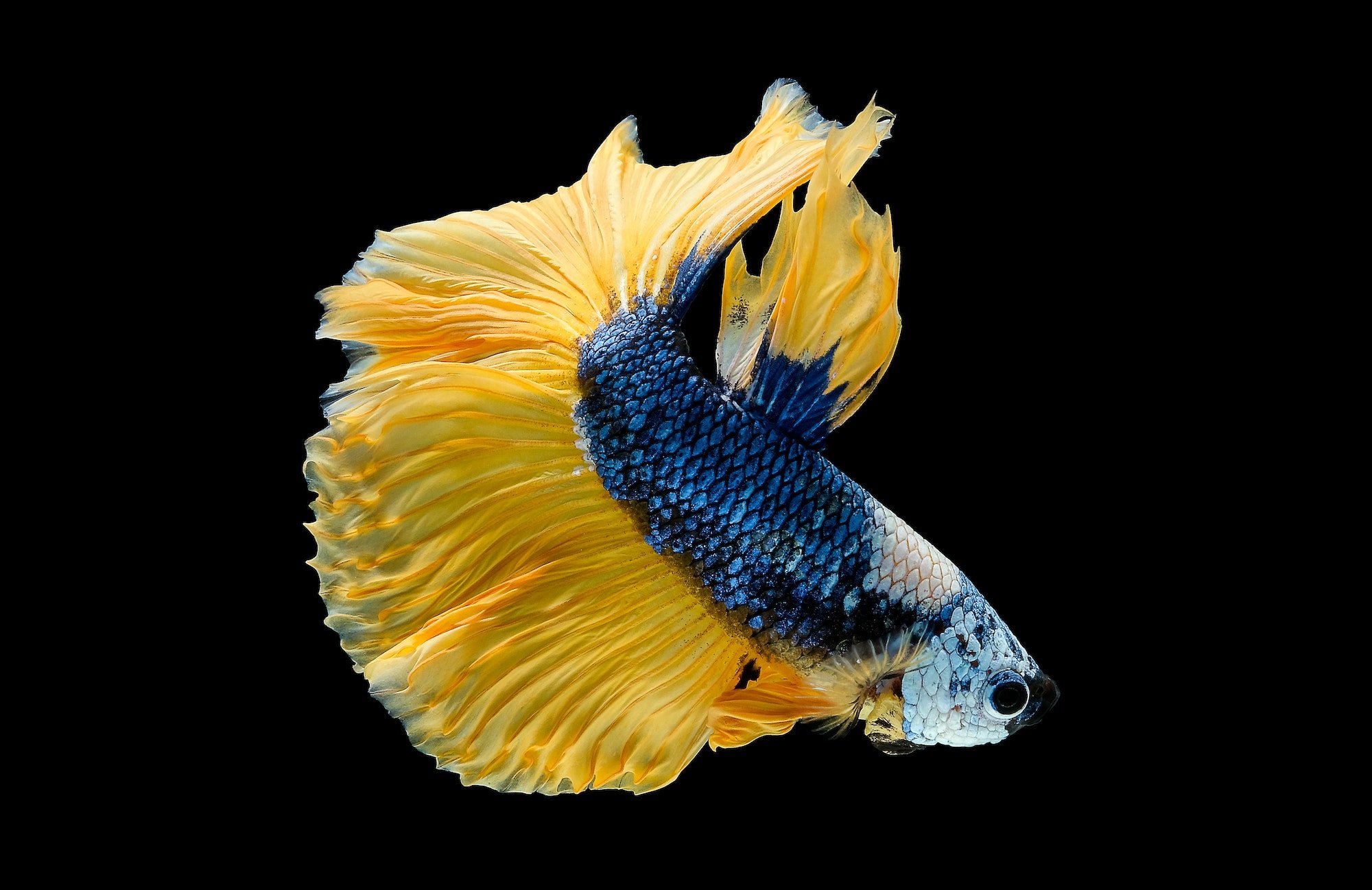
Leave a Reply